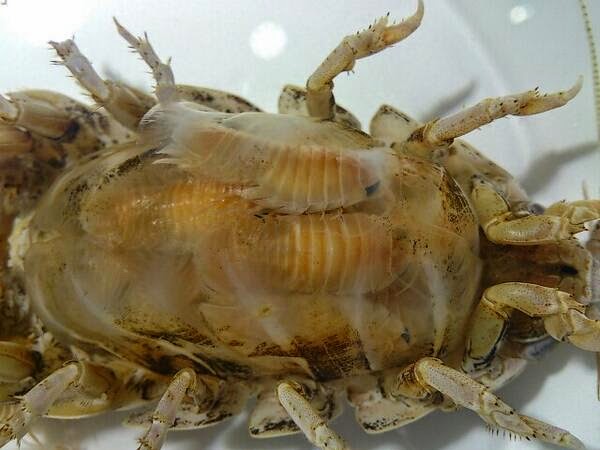Today, Craig McClain, along with a massive team of ocean scientists (including me!) published our monumental paper: Sizing ocean giants: patterns of intraspecific size variation in marine megafauna. This massive monograph investigates patterns of size among 25 ocean giants, the biggest, most massive members of their respective taxa. You can probably guess which species I had a hand in reviewing.
httpv://www.youtube.com/watch?v=xtk5t7sSb3s
Along the way, I learned quite a few cool things about the magnificent giants of the deep sea.
1. Giant deep-sea isopods are sexually dimorphic.
This was, perhaps, the most notable isopod related finding of our paper. By pooling from hundreds of records across dozens of databases, we were able to statistically show sexual dimorphism in giant isopods. Both sexes are huge, compared to their roly-poly cousins, but if you’re staring at a half-meter beast, you’re almost certainly looking at a male. Males, on average, were 5 cm longer than females.
2. Giant deep-sea isopod reproduction is seasonal.
It makes sense. During the winter and spring, plankton blooms bring more biomass to the seafloor. Giant isopods are scavengers, they live or die by what they can find rotting on the seafloor and will get busy making babies when their is more abundant food.
3. Female giant deep-sea isopods carry their young around in a pouch.
It’s called a marsupium (same word root as marsupial) and is formed from overlapping plates of their exoskeleton called oostegites. There’s a tremendously adorable picture of another Bathynomous species carrying her young in a marsupium over at the Echinoblog.

4. Some of the deep-sea isopod reproductive structures are also seasonal.
Giant deep-sea isopods don’t have oostegites all the time. During the summer months, these structures are absent from females.
5. Baby deep-sea isopods look like adult deep-sea isopods.
They eschew a larval stage and go straight to juveniles, called manca, they look pretty much exactly like tiny versions of their gigantic parents. Neat!
6. You can rock out to the ultimate Giant Isopod mix tape.
Yes, Songs About Giant Isopods exists, it has 17 tracks, and every one of them is amazing. There’s even a music video
httpv://www.youtube.com/watch?v=J6AiZaGBal0
hi Dr. Thaler – the link to the paper doesn’t work. just wondering: did anyone review jellies?
Thanks, link fixed. We did look at lions mane jellies. Enjoy!
thanks! much appreciated.
One species of deep sea marine isopod, Booralana tricarinata , can only perceive a maximum of 4 flashes of a flickering light every second before it sees it as a constant source of light (compared with about 60 for a human, or 100 for a pigeon ). Full paper at http://jeb.biologists.org/content/215/19/3344.full and more on variation of speed of the visual system from a paper of ours that is open access http://www.sciencedirect.com/science/article/pii/S0003347213003060